Tarik Ibrahim Graduate Education and Research (TIGER) Fund
Loyola Medicine and the Department of Neurological Surgery have created the Tarik Ibrahim Graduate Education and Research (TIGER) Fund to promote neurosurgery resident’s research and education, and to acknowledge Tarik’s dedication to both his patients and the residency program. Tarik's impressive accomplishments and his immense dedication will have a long-lasting influence on the Loyola University Medical Center. The hospital proudly displays Tarik's portrait and biographical plaque in the area connecting the Neurosurgical Intensive Care Unit to the Operating Rooms, known as Tarik's Path, as well as in the Neurosurgical Conference Room. Tarik will be an inspiration to patients, staff and future residents alike for years to come. The balance of Tarik’s image in both the educational and clinical setting is ideal given his passions.
Tarik’s presence will inspire all patients, staff and future residents alike for years to come.
About Tarik F. Ibrahim, MS, MD
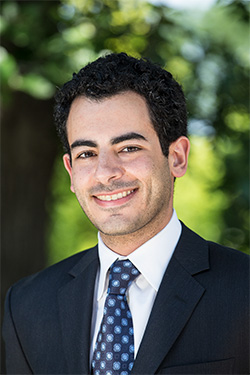 Tarik F. Ibrahim, M.S., M.D., a native of Grosse Pointe Shores, Michigan, was born on September 2, 1981. Tarik completed his Bachelor of Science at Michigan State University in 2004, his Master of Science at Wayne State University in 2006, his Medical Degree at Penn State University in 2010, and began a 7-year Neurosurgical Residency at Loyola University Medical Center. He completed a six-month fellowship training with world-renowned neurosurgeon Dr. Juha Hernesniemi in Helsinki, Finland. Tarik was accepted to the prestigious skull base and cranial nerve surgery fellowship at the Swedish Medical Center in Seattle, Washington.
Tarik F. Ibrahim, M.S., M.D., a native of Grosse Pointe Shores, Michigan, was born on September 2, 1981. Tarik completed his Bachelor of Science at Michigan State University in 2004, his Master of Science at Wayne State University in 2006, his Medical Degree at Penn State University in 2010, and began a 7-year Neurosurgical Residency at Loyola University Medical Center. He completed a six-month fellowship training with world-renowned neurosurgeon Dr. Juha Hernesniemi in Helsinki, Finland. Tarik was accepted to the prestigious skull base and cranial nerve surgery fellowship at the Swedish Medical Center in Seattle, Washington.
Tarik as Neurosurgeon
During his professional training, Tarik became increasingly interested in skull base and cranial nerve surgery, a complex, physically and emotionally demanding sub-specialty. Tarik “was meticulous in the clinic and hospital, but never seemed over-burdened by the details of our work…He performed a beautiful craniotomy and placed his first aneurysm clip [a straight 14mm Sugita titanium non-ferromagnetic bayoneted clip] successfully, steadily, expertly, and perfectly” (Douglas E. Anderson, M.D., Professor and Department Chairman, Neurological Surgery). Several of his colleagues enthusiastically mentioned, “That aneurysm never stood a chance.”
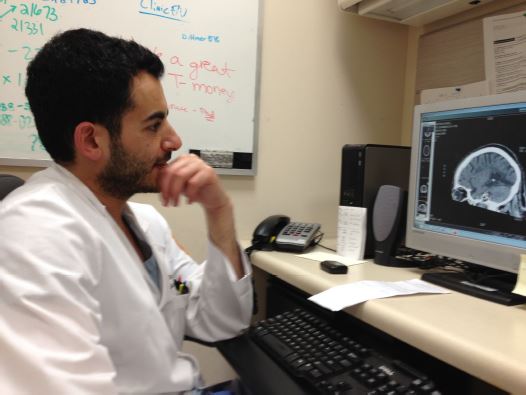
Tarik discovered a treatable cause to what was thought to be permanent blindness following spinal surgery; a breakthrough in medical practice that solidifies his legacy in the field of Neurosurgery forever.
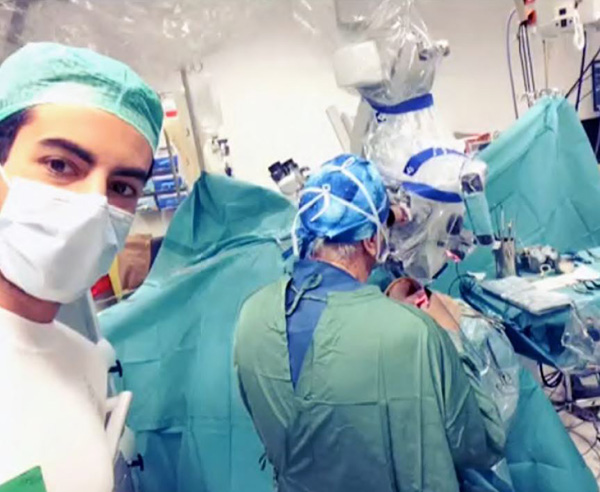
Tarik is a highly published author of 26 journal articles and book chapters in the US and abroad, with first authorship on several. He presented at multiple national and international conferences, including 8 oral, video and poster presentations. Thus, Tarik’s academic achievements, including his 35 publications and presentations, have contributed to the neurosurgical and neuroscientific disciplines. He was passionate about educating himself and those around him.
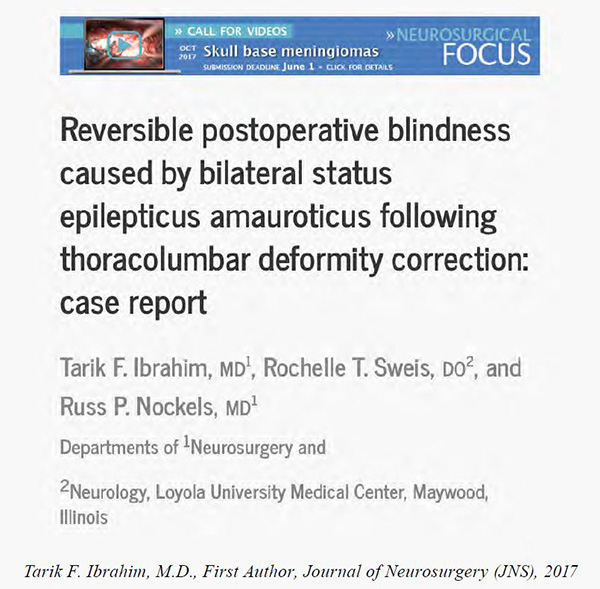
Kudos for Tarik
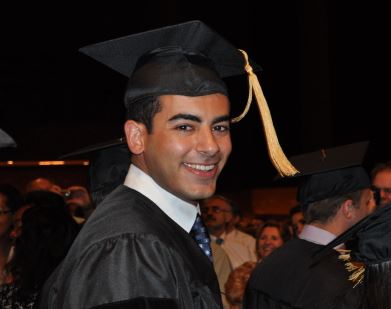
As Russ P. Nockles, M.D., Professor and Vice Chairman of Neurological Surgery stated,
"Without question, this man would have been permanently blind if not for Tarik’s strong dedication toward going far beyond what was normally necessary to help patients. His actions flew in the face of global medical knowledge. In fact, one may wonder how many patients may have suffered permanent blindness because no one was as clever and persistent as Tarik to find a treatable cause under similar circumstances. That will no longer be the case. This patient’s story is being reported worldwide in a publication authored by Tarik.
It will surely stand as a literally sight-saving scholarly work that will help many patients in the future. As importantly, it will always stand as a testament to Tarik’s astonishing passion for helping patients even when all else had presumably failed. His work on this single patient will justifiably solidify his legacy in the field of Neurosurgery forever."
“Tarik received more compliments from patients than most. They experienced his kindness and concern, recognized that his utmost concern would be their well-being.”
- Professor and Department Chairman of Neurological Surgery at the Loyola University Medical Center, Douglas E. Anderson MD
“At the Hines VA Hospital across the street, a veteran with crippling back pain was hobbling towards the elevator. Dozens of people with busy schedules were there in the lobby just waiting. Tarik left to get a wheelchair, assisted the elderly patient into it, wheeled him into the elevator, and took him to clinic. I am sure that genuine, kind act left a long-lasting, positive imprint on that veteran patient. The impact that event had on me remains alive today. For you see, I was also in that lobby, consumed with my busy schedule, not paying attention to the needs of others at all times. That was my first day with Tarik three years ago and that is my enduring image of him.”
- Associate Professor and Residency Program Director of Neurological Surgery at the Loyola University Medical Center, Anand V. Germanwala, MD
Tarik was known throughout his career as “Dr. LOVE” to patients and colleagues because of his warm smile, caring heart, and affectionate demeanor. Anand Germanwala M.D, Associate Professor and Residency Program Director at Loyola University Medical Center, emphasized, “His peers looked up to him as an incredible resident, teacher and advocate. However, he was not only defined through his budding career in neurosurgery, but was also recognized for his compassion, loyalty, ambition, and character. He is very bright and motivated, and has a refreshing sense of humor. His smile is contagious and he made everyone around him better. Tarik is an avid Michigan State Spartans and Detroit city sports fan (particularly the Tigers), and his family and friends are most important to him.” An avid skier, world traveler, black belt in Taekwondo, sailor, and lover of literature and music, Tarik is a loving son, cousin, nephew, uncle, godfather and friend, and his energy and love of life is infectious.
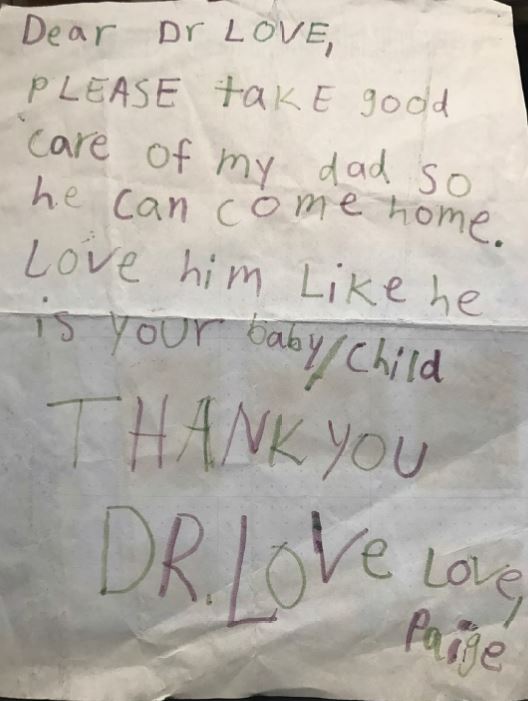
Remembrances for Tarik
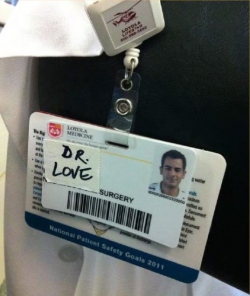
The Loyola Medical Center presented Tarik’s parents with Tarik’s Certificate of Neurological Surgery, as he had acquired all the technical skills, character, drive, and judgment to be an independently practicing neurosurgeon a full year ahead of schedule.
Tarik’s high school alma mater, University Liggett School, named the Upper School Commons Area in his honor. Tarik’s portrait and biographical plaque hang prominently at the entrance of the Tarik F. Ibrahim, M.S., M.D. Tarik’s Commons Area. This will inspire current students and generations of future students who will see his name and be reminded of his many accomplishments.
Tarik’s medical school, the Penn State College of Medicine, with the assistance of Robert E. Harbaugh M.D., Distinguished Professor and Chair of Neurosurgery, Milton S. Hershey Medical Center, established the Tarik F. Ibrahim, M.S.,M.D., ’10 Award in Neurosurgery that recognizes an outstanding fourth-year medical student intending to pursue a career in neurosurgery.
The Health and Medicine Policy Research Group created The Tarik F. Ibrahim M.S., M.D. Fund to honor Tarik’s calling of ensuring the health and well-being of underserved populations. This fund supports a Schweitzer Fellow proposing to work with this population.
Tarik was known throughout his career as “Dr. LOVE” to patients and colleagues because of his warm smile, caring heart, and affectionate demeanor. Anand Germanwala M.D, Associate Professor and Residency Program Director at Loyola University Medical Center, emphasized, “His peers looked up to him as an incredible resident, teacher and advocate. However, he was not only defined through his budding career in neurosurgery, but was also recognized for his compassion, loyalty, ambition, and character."
Tarik's Biography
Tarik's Path
Tarik F. Ibrahim, M.S., M.D., was a native of Grosse Pointe Shores, Michigan. Tarik F. Ibrahim was born on September 2, 1981. He began a long and distinguished academic career at the Grosse Pointe Academy (kindergarten through third grade) and graduated lower, middle and high school from University Liggett School in 1999. Tarik completed his undergraduate studies at Michigan State University in 2004, followed by a Master of Science in 2006 from Wayne State University. He left Michigan for medical school, obtaining his medical degree from Penn State University in 2010.
Directly upon graduation from medical school, Dr. Tarik Ibrahim began a 7-year Neurosurgical residency at Loyola University Medical Center in Maywood, IL. Additionally, he completed a six-month training in cerebrovascular and micro-neurosurgery with the world-renowned neurosurgeon Dr. Juha Hernesniemi in Helsinki, Finland.
As Tarik stated on June 17, 2015, “It’s been an incredible 6 months. I’ve learned a ton, made new friends and explored parts of the world I’d always dreamed of. Thank-you to my family for supporting me, to Prof Hernesniemi for the opportunity and to all the friends, new and old, that joined me on this awesome journey #soumi.”

Recently, Dr. Tarik Ibrahim was accepted to a prestigious fellowship at the Swedish Medical Center in Seattle, Washington to begin a specialization in skull base and cranial nerve surgery in the summer of 2018.
During his professional training, Tarik became increasingly interested in skull base and cranial nerve surgery, a complex, physically and emotionally demanding sub-specialty. Tarik “was meticulous in the clinic and hospital, but never seemed over-burdened by the details of our work… He performed a beautiful craniotomy and placed his first aneurysm clip [a straight 14mm Sugita titanium non-ferromagnetic bayoneted clip]- successfully, steadily, expertly, and perfectly,” said Douglas Anderson, M.D., Professor and Department Chairman, Neurological Surgery at Loyola University Medical Center. Several of his colleagues enthusiastically mentioned, “that aneurysm never stood a chance.”
Russ Nockels, M.D., Vice Chairman, Professor Loyola University Medical Center, detailed this revolutionary and “… remarkable story of a patient of ours who became temporarily blind, and had his eyesight restored by Tarik's hard work & dedication….”
Tarik & I performed the surgery as planned….
I saw the patient about an hour after we finished and although slightly confused he seemed to be recovering well. Several hours later however, Tarik called to say the patient was blind.
Let me digress a bit about the known risks associated with the type of surgery this gentleman had. First, other than death, visual loss is the most feared complication of spinal surgery… Most discouraging of all is the notion that such an event is irreversible, one can do nothing to improve it.
Knowing all these issues, however, did not discourage Tarik. Against all medical knowledge at the time, he ordered a very sophisticated analysis of the patient’s brain activity looking for seizures… The seizure disorder he was looking for had never been cited as a cause of blindness and had only been reported very rarely in children as a passing event.
Incredibly, his suspicion was correct… Because of this finding the patient was immediately placed on high dose anti-seizure medication and in fact was required to be placed in a medical coma for several days to break the seizures.
When the patient awoke, the first thing he noted is that he could see again, and to this day his eyesight has remained permanently restored.
As Russ P. Nockels, M.D., Professor and Vice Chairman of Neurological Surgery stated,
“Without question, this man would have been permanently blind if not for Tarik’s strong dedication toward going far beyond what was normally necessary to help patients. His actions flew in the face of global medical knowledge. In fact, one may wonder how
many patients may have suffered permanent blindness because no one was as clever and persistent as Tarik to find a treatable cause under similar circumstances. That will no longer be the case. This patient’s story is being reported worldwide in a publication authored by Tarik. It will surely stand as a literally sight-saving scholarly work that will help many patients in the future. As importantly, it will always stand as a testament to Tarik’s astonishing passion for helping patients even when all else had presumably failed. His work on this single patient will justifiably solidify his legacy in the field of Neurosurgery forever.”
Alongside Tarik’s ambitions in the operating room, one of his most impressive successes was being a highly published author of 26 journal articles and book chapters. In six years in the United States, Tarik published a total of eight peer-reviewed journal articles. Additionally, Tarik has published five book chapters, with first authorship on several.
Abroad, his talents were just as impressive. Remarkably, during his short six-month tenure in Helsinki, Finland, he was able to successfully publish ten peer-reviewed journal articles, 4 book chapters and 1 online scholarly contributions for international readership, once again taking first authorship on several.
In tandem with his 26 publications, Tarik participated in multiple supplementary academic endeavors. These achievements include two videos (one published and one presented at a conference), two oral presentations, and three poster presentations. He also organized and assisted in two hands-on courses given at conferences, and attended multiple conferences nationally and internationally to further educate himself beyond the requirements of his neurosurgical surgery residency.
Tarik’s multiple professional contributions, including his 35 publications and presentations, have thus impacted the future of the neurosurgical and neuroscience disciplines, as well as the scientific field in general.
A longtime professional colleague and personal friend emphasized, “I am beyond stunned at how much Tarik accomplished in residency with so little time. Beyond stunned and filled with so much pride and love.”
As Dr. Anderson stated,
“Tarik received more compliments from patients than most. They experienced his kindness and concern, recognized that his utmost concern would be their well-being. He was meticulous in the clinic and hospital… He loved music in the OR and he and I talked about this frequently: from Motown classics, to new music, to more philosophical ideas comparing various musical genres that were coming into being and their effect on society and individuals… Tarik was the best.
…Tarik and I sat down together for a conversation about how absolutely important it was to me, and to everyone else, that he set the tone and the culture for our department. I came to know the depth and beauty of his character. His agreement to take part in that request, and how he took that unto himself in body, mind and soul, was profound, and its effects will last the lifetime of everyone who came in contact with him and knew him. I say that without any exaggeration, as every resident attests to his patience, his skill, his talent and compassion; every nurse, everybody that works in the hospital will say the same. All my colleagues are in agreement, such that we very much want him as a colleague for the rest of our careers. Obviously, he was much loved.”
Dr. Nockels stated, “Tarik's presence will continue to be felt by those things that make life livable and special. There are many patients who walk today because of his dedication, who see because of his perseverance, who hear because of his intelligence, and who breathe because of his love. We are all better doctors, nurses, students…indeed people...for knowing Tarik… Tarik has proven that one's good and kind work can be eternal… Great man… I love Tarik like a son and like a son he will remain in my heart forever.”
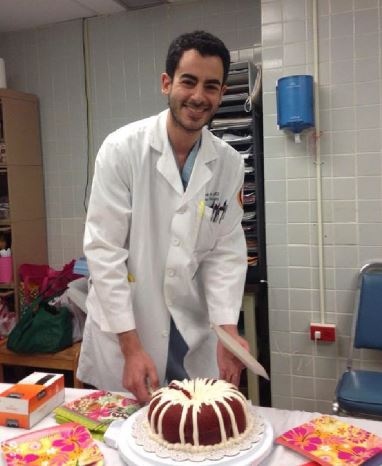
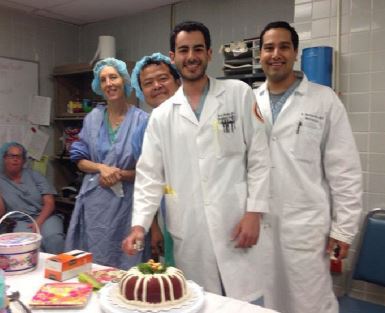
Despite the hard work and sacrifices he made, Tarik was known throughout his career as “Dr. LOVE” to patients and colleagues alike because of his warm smile and affectionate demeanor. As one of Tarik’s former patients emphatically stated, “I know I cannot stop thinking of Dr. Ibrahim (he always said ‘Call me Tarik’ and I told him ‘I cannot… I have so much respect for you!’… I will always smile when I think of his ‘Thumbs Up’ to me just before my surgery… I will treasure the blessing of his presence in my life.”
Further reflecting on Tarik’s profound impact, Anand V. Germanwala M.D., Associate Professor and Residency Program Director of Neurological Surgery at Loyola University School of Medicine, described Tarik’s character.
At the Hines VA Hospital across the street, a veteran with crippling back pain was hobbling towards the elevator. Dozens of people with busy schedules were there in the lobby just waiting. Tarik left to get a wheelchair, assisted the elderly patient into it, wheeled him into the elevator, and took him to clinic. I am sure that genuine, kind act left a long-lasting, positive imprint on that veteran patient. The impact that event had on me remains alive today. For you see, I was also in that lobby, consumed with my busy schedule, not paying attention to the needs of others at all times. That was my first day with Tarik three years ago and that is my enduring image of him.
Dr. Germanwala additionally stressed that, “Tarik's peers look up to him as an incredible resident, teacher and advocate. However, he is not only defined through his budding career in neurosurgery but is also recognized for his compassion, loyalty, ambition, and character. He is very bright and motivated, and has a refreshing sense of humor. His smile is contagious and he makes everyone around him better. He is an avid Michigan State Spartans and Detroit city sports fan (particularly the Tigers), and his family and friends are most important to him. A loving son, cousin, nephew, uncle, godfather and friend, Tarik’s energy and love of life was infectious.”
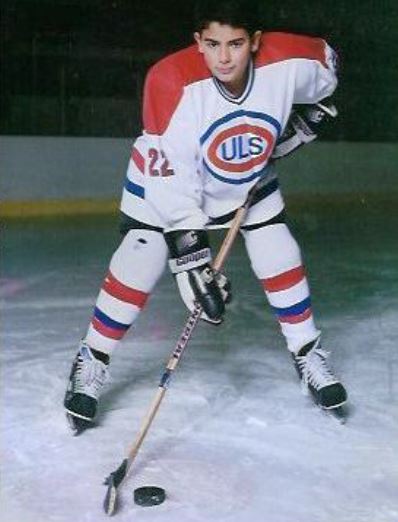
Beyond his academic and medical career, Tarik was equally successful and well-loved in his personal life. He was an avid skier, world traveler, black belt in Tae Kwon Do, and loved literature and music. In addition, Tarik was an active member of the Grosse Pointe Yacht Club (GPYC) along with his parents since 1991, a Legacy member since 2006, and a Social member since 2012. He learned and loved to sail at GPYC. Tarik’s lifelong friends expressed, “Tarik’s energy and love of life is infectious...He manages to juggle work, research and social activities defying all laws of physics.
Through the lens of Tarik’s family and friends, “Tarik Ibrahim, the best son anyone can wish for.”...“I have known Tarik since elementary school and loved this charming prince since.”...“Tarik is a very special brilliant young man with the most dazzling smile.”
The University Liggett School, “ULS”, Tarik’s high school, named the Upper School Commons Area in Tarik’s honor. Tarik’s portrait and biographical plaque are hanging prominently at the entrance of the Tarik F. Ibrahim, M.S., M.D. Commons Area, informally known as Tarik Commons. This will inspire current students and generations of future students who will see his name and be reminded of his many accomplishments. www.uls.org/tarik
Tarik’s medical school, the Penn State College of Medicine, stated that he made such a lasting impact on his fellow alumni and friends that they took it upon themselves to establish an endowment that would celebrate and honor Tarik’s passion for neurosurgery and love for his alma mater. The Tarik F. Ibrahim, M.S., M.D. ’10 Award in Neurosurgery will be awarded to an outstanding fourth-year medical student enrolled in the Penn State College of Medicine who is intending to pursue a career in neurosurgery.
Dr. Robert E. Harbaugh, M.D., FAANS, FACS, FAHA, Director of Penn State Neuroscience Institute, Professor of Department of Engineering Science and Mechanics, Distinguished Professor and Chair of Department of Neurosurgery, was integral in the establishment of this fund. Dr. Harbaugh, in collaboration with the leaders of the Neurosurgery Student Interest Group, will choose the reward recipient each year. The beneficiary of this scholarship will receive a monetary award accompanied by a plaque with Tarik’s graduation picture, honoring his legacy as a proud and successful graduate of the Penn State College of Medicine.
The first Tarik F. Ibrahim, M.S., M.D. ’10 Award in Neurosurgery will be gifted annually and for the first time Spring of 2017. engage.pennstatehershey.org/ibrahimaward
The Health and Medicine Policy Research Group honored Tarik’s legacy by creating The Tarik F. Ibrahim, M.S., M.D. Fund. This will support a Schweitzer Fellow who has proposed to work with refugees or immigrants, honoring Dr. Ibrahim’s calling of ensuring the health and well-being of underserved populations. This fund was started by a Fellow for Life who was deeply inspired by Dr. Ibrahim’s life: “The legacy that I want to share about Tarik Ibrahim is that he was the most selfless person I’ve ever met. His character and accomplishments were undoubtedly a reflection of the love and support he received throughout his life from his parents.
He was so giving of himself to others in every aspect of his life. Treating his friends and family with love, care and compassion was instinctive to him, as it was to treat strangers like friends, as it was to offer himself in the little free time he had to be of service to others and help mentor medical students and younger residents. He never once complained about the hours he worked or how little time he had to himself. He truly enjoyed being a doctor and caring for the sick. It was his calling. It brought him joy and filled him with life.”
In commemoration of Tarik’s accomplishments, Loyola University Medical Center held a memorial for Tarik on August 3, 2016, where Dr. Germanwala presented Drs. Fikry and Mona Ibrahim with Tarik’s Certificate of Neurological Surgery, marking his completion of all residency requirements. Despite having a year left, the Department of Neurological Surgery felt that Tarik had acquired all the technical skills, character, drive, and judgment to be an independently practicing neurosurgeon a full year ahead of schedule. "Tarik is an incredible young man beaming with ambition, intelligence and compassion. Simply put, he made us all better.”
Tarik’s impressive accomplishments and his immense dedication will have a long-lasting influence on the Loyola University Medical Center. The hospital proudly displays Tarik’s portrait and biographical plaque in the area connecting the Neurosurgical Intensive Care Unit to the Operating Rooms, known as Tarik’s Path, as well as in the Neurosurgical Conference Room. The balance of Tarik’s image in both the clinical and educational setting is ideal given his passions. Tarik’s presence will inspire all patients, staff and future residents alike for years to come.
The Loyola University Medical Center established a fund in Tarik’s honor, named the Tarik Ibrahim Graduate Education and Research (TIGER) Fund, to acknowledge Tarik’s dedication to his patients, his passion for research and resident education. loyolamedicine.org/tigerfund
Through the support of the Tarik Ibrahim Graduate Education and Research Fund or TIGER Foundation, Dr. Germanwala stated “I have started an Annual TIGER Resident Research Day in the Loyola Stritch School of Medicine that helps promote resident research education-held the inaugural event on Wednesday, July 21, 2017.”
TIGER Resident Research Award will be awarded to a resident who presented the finest research. The faculty will choose the reward recipient each year. The beneficiary will be receiving this fine honor of a Certificate with Tarik’s name Tarik Ibrahim Graduate Education and Research Resident Award- accompanied by a small cash award. Only through the TIGER fund The Neurosurgery department is able to present this award and host such a nice event. The Award will be gifted annually and for the first time Summer of 2017. A track will be kept of the annual winners with a plaque in the Neurosurgery department.
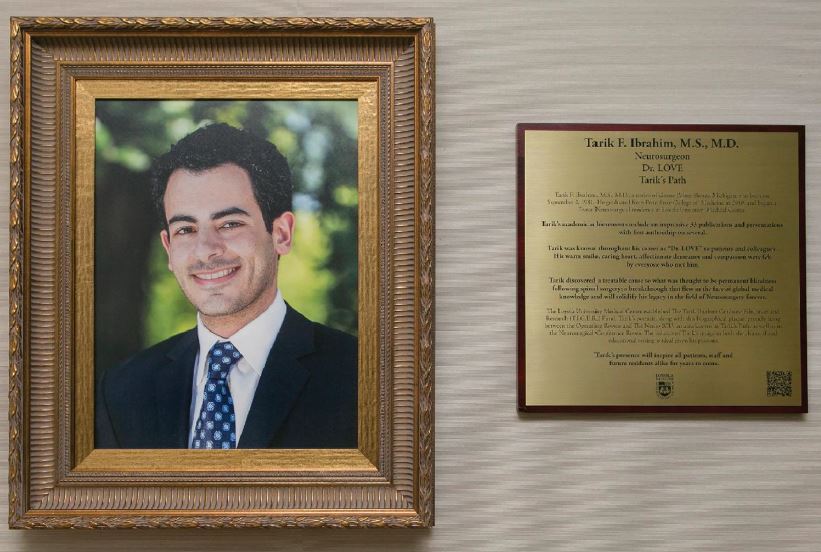
Tarik’s Portrait and Biological Plaque displayed in the Neurosurgical Conference Room, Loyola.
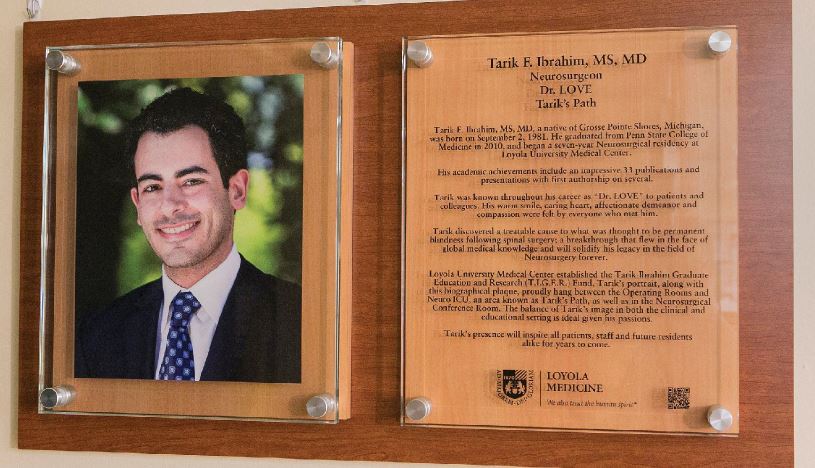
Tarik’s Portrait and Biological Plaque displayed in the ICU-Tarik’s Path, which is in the area connecting the Neurosurgical Intensive Care unit to the operating rooms.
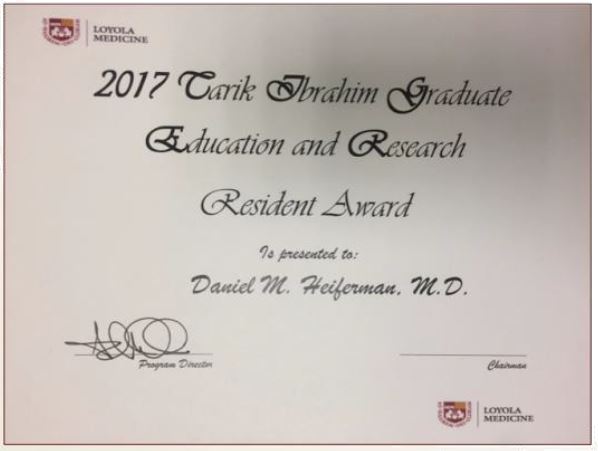
Tarik Ibrahim Graduate Education and Research Resident Award, TIGER
The Annual Award will be gifted to a resident who presented the finest research. Loyola University.
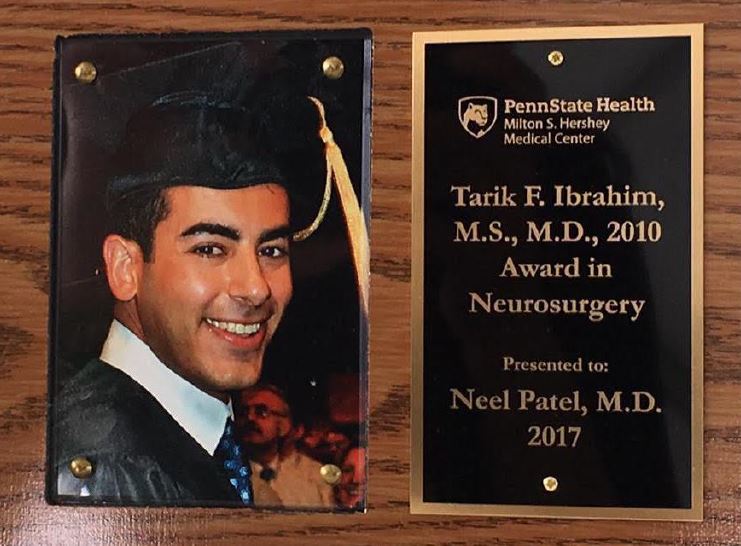
Tarik F. Ibrahim, M.S., M.D. ’10 Award in Neurosurgery
Annually awarded to an outstanding fourth-year medical student enrolled in the Penn State College of Medicine who is intending to pursue a career in neurosurgery.
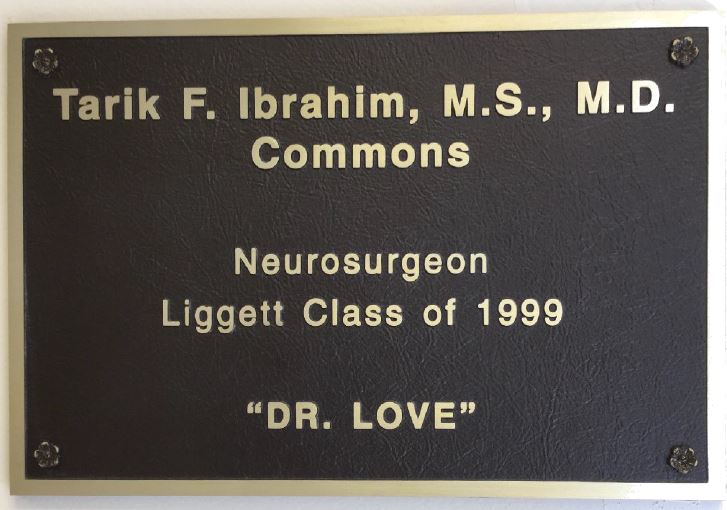
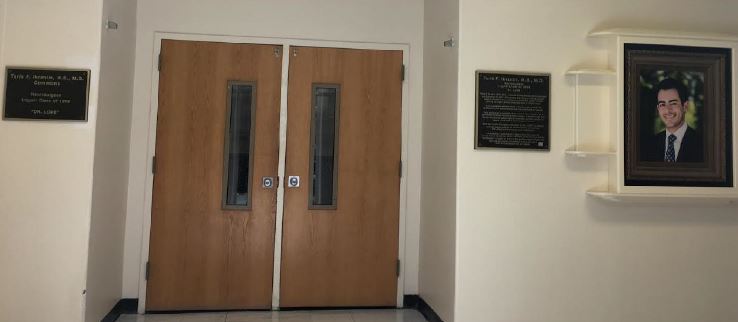
As a reminder of Tarik’s legacy, the University Liggett Upper School Commons Area is named in Tarik’s honor. The official name will be the Tarik F. Ibrahim, M.S., M.D. Commons, informally known as the Tarik Commons. Tarik’s portrait and biographical plaque will hang prominently at its entrance.
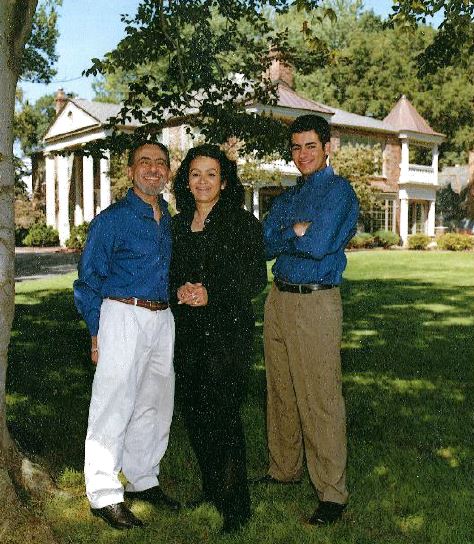
“You gave me The Best years of my life ... and for that I am Eternally Grateful. You are my God given Gift my beautiful SON. Always remember how much you make your mom PROUD! I Love you more than you will ever know ...Till we meet again Habiby.”
-Tarik’s Mom, Dr. Mona Rizk Ibrahim
Tarik's Curriculum Vitae
I. Current Position:
Neurosurgeon
Neurological Surgery Resident PGY-7
Loyola University Medical Center
2160 South First Avenue
Building 105, Room 1900
Maywood, Illinois, U.S.A. 60153
II. Personal Data:
Date of Birth: September 2, 1981
Phone Number: 517.449.5909
E-mail: Tarik.ibrahim@gmail.com
III. Education:
- 2016 Certificate of Neurological Surgery Completion, Loyola University Affiliated Hospitals. Chicago, IL
- 2010 M.D. Penn State College of Medicine. Hershey, PA.
- 2006 M.S. Basic Medical Sciences. Wayne State University. Detroit, MI.
- 2004 B.S. Human Biology. Michigan State University. East Lansing, MI.
IV. Postgraduate Education:
- 7/2010- 8/2016 Loyola University Medical Center Department of Neurological Surgery Residency
- 1/2015-6/2015 Hernesniemi-Aesculap Cerebrovascular Microneurosurgery Fellowship
- 1/2014-6/2014 Edward Hines, Jr. VA Hospital, Chief Resident in Neurological Surgery
- 1/2013-3/2013 Ann & Robert H. Lurie Children’s Hospital of Chicago, Resident in Pediatric Neurological Surgery
V. Certification and Licensure:
- Certification: American Board of Neurologic Surgery 2014
- Licensure: Illinois 125058388
VI. Peer-Reviewed Publications:
- Ackerman PD, Hammers RL, Ibrahim TF, Origitano TC. The Use of Abdominal Free Fat for Volumetric Augmentation and Primary Dural Closure in Supratentorial Skull Base Surgery: Managing the Stigma of a Temporal Defect. Journal Neurological Surgery, 2012 Apr; 73 (2): 139-44.
- Ibrahim TF, Ackerman PD, Welch KC, Prabhu VC. Trans-pterygoid Stent Placement for Management of a Recurrent Infra-temporal Fossa Epidermoid Cyst: A Technical Note. Journal Neurological Surgery, 2013 Dec; 74(2): 123-8.
- Amin BY, Mummaneni PV, Ibrahim TF, Zouzias A, Uribe J. 4-Level Minimally Invasive Lateral Interbody Fusion For Treatment of Degenerative Scoliosis. Neurosurgical Focus, 2013 July. Vol Supp, No V2, Video 10.
- Dibble C, Wemhoff M, Ibrahim TF, Sasaki-Adams D, Solander S, Germanwala AV. Ruptured Arteriovenous Malformation Presenting with Kernohan’s Notch: A Case Report. Reports in Neurological Medicine, 2015.
- Ibrahim TF, Garst JR, Burkett DJ, Toia GV, Braca JA, Hill JP, Anderson DE. Microsurgical Pontine Tractotomy in Cases of Intractable Trigeminal Neuralgia. Operative Neurosurgery, 2015 Dec; 11(4): 518-529
- Andrade-Barazarte H, Kievelev J, Goehre F, Jahromi BR, Noda K, Ibrahim TF, Kivisaari R, Lehto H, Jaaskelainen J, Niemela M, Hernesniemi J. Contralateral Approach to Bilateral Middle Cerebral Artery Aneurysms: Comparative Study, Angiographic Analysis and Surgical Results, Neurosurgery, 2015 Dec; 77(6): 916-26
- Andrade-Barazarte H, Luostarinen T, Goehre F, Kivelev J, Jahromi BR, Ludtka C, Lehto H, Raj R, Ibrahim TF, Niemela M, Jaaskelainen JE, Hernesniemi JA. Transeient Cardiac Arrest Induced By Adenosine: A Tool for Contralateral Clipping of Internal Carotid Artery-Ophthalmic Segment Aneurysms. World Neurosurgery, 2015 Dec; 84(6): 1933-1940
- Ibrahim TF, Jahromi BR, Miettinen J, Raj R, Andrade-Barazarte H, Goehre F, et al. Long-Term Causes of Death and Excess Mortality After Carotid Artery Ligation. World Neurosurgery, 2016; 90:116-22.
- Ibrahim TF, Hafez A, Andrade-Barazarte H, Raj R, Niemela M, Lehto H, et al. De novo giant A2 aneurysm following anterior communicating artery occlusion. Surgical Neurology International, 2015; 6(Suppl 21): S560-5.
- Goehre F, Yanagisawa T, Kamiyama H, Noda K, Ota N, Tsuboi T, Miyata S, Matsumoto T, Ibrahim TF, Andrade-Barazarte H, Jahromi BR, Tokuda S, Tanikawa R. Direct Microsurgical Embolectomy for An Acute Distal Basilar Artery Occlusion. World Neurosurgery, 2016; 86: 497-502.
- Ibrahim TF, Hill JP, Anderson DE. Spinal cord cavernoma resection using a fiber-optic CO2 laser. Acta Neurochirurgica (Wien), 2015; 157(12): 2157-60
- Hafez A, Ibrahim TF, Raj R, Antinheimo J, Siironen J, Hernesniemi J. Delayed Migration of Fractured K-wire Causing Vertebral Artery Invagination After Anterior Atlantoaxial Fixation: A Case Report. World Neurosurgery, 2016; 88: 695.e5-10
- Goehre F, Jahromi BR, Lehecka M, Lehto H, Kivisaari R, Andrade-Barazarte H, Ibrahim, TF, et al. Posterior Cerebral Artery Aneurysms: Treatment and Outcome Analysis in 121 Patients. World Neurosurgery, 2016; 92: 521-32
- Lazukova M, Andrade-Barazarte H, Makhamov M, Kivelev J, Goehre F, Jahromi BR, Ibrahim TF, et al. The orbitozygomatic stich: A technical modification of the lateral supraorbital approach. Surgical Neurology International, 2016; 7:46.
- Gange WS, Ibrahim TF, et al. Ophthalmic Complications Following Acoustic Neuroma Resection. Operative Neurosurgery, 2017 (in press).
- Johans SJ, Garst JR, Burkett DJ, Granhnke K, Martin B, Ibrahim TF, Anderson, DE, Parbhu VC. Identification of Preoperative and Intraoperative Risk Factors for Complications in the Elderly Undergoing Elective Craniotomy. World Neurosurgery, 2017: DOI: http://dx.doi.org/10.1016/j.wneu.2017.07.177
- Ibrahim, TF, Sweis RT, Nockels RP. Reversible Postoperative Blindness caused by Bilateral Status Epilepticus Amauroticus Following Thoracolumbar Deformity Correction: Case Report, Journal of Neurosurgery, 2017 April, 1-5.
VII. Book Chapter Published or In Print:
- Amin B, Ibrahim TF, Wadhwa R, Mummaneni P. Is an Interbody Fusion Always Necessary? In Harrop J, Vaccaro A (eds.): Adult Degenerative Scoliosis. New Delhi, Jaypee Brothers Medical Publishers, 64-74, 2015.
- Germanwala AV, Ibrahim TF, Singh A. Endoscopic Endonasal Approaches to the Anterior Cranial Fossa. In Payne SC, Singh A, Woodworth BA (eds.): Surgical Techniques in Otolaryngology-Head & Neck Surgery: Sinonasal Surgery. New Delhi, Jaypee Brothers Medical Publishers, 221-228, 2015.
- Ibrahim TF, Bowman RM, McLone DG. Spinal Lipomas. In Cohen A (ed.): Pediatric Neurosurgery: Tricks of the Trade.
- Ibrahim TF, Amin B, Nockels RP. Back, Neck and Limb Pain. In Biller J and Salardini A (eds.): Hospital Neurology.
- Ibrahim TF, Maxwell S, Iqbal O. Current Anticoagulant Drugs and Mechanisms of Action. In Loftus CM (ed.): Anticoagulation for the Neurosurgeon and Hemostasis in Neurosurgery. Springer International Publishing, 33-46, 2016.
- Ibrahim, Tarik F., Nockels, Russ P., and Groff, Micheal W. “Approach to Patient with Failed Back Syndrome.” Practical Neurology. By Jose Biller. 5th ed. New York: Lippincott Williams & Wilkins, 2017. 283-90.
- Hernesniemi J, Ibrahim TF, Goehre F, Andrade-Barazarte H, Jahromi BR. Supraclinoid Internal Carotid Artery Aneurysms. In Macdonald RL (ed.): Neurosurgical Operative Atlas: Vascular Neurosurgery.
VIII. Submitted Book Chapters
- Jahromi, BR, Ibrahim, TF, Choque-Velasquez, J, Andrade-Barazarte, H, Hernesniemi, J. “Anterior Cerebral Artery Aneurysms.” Decision Making in Cerebrovascular Diseases by Rangel-Castilla, Nakaji, Siddiqui, Spetzler, and Levy.
- Ibrahim, TF, Jahromi, BR, Hijazy, F, Kozyrev, DA, Goehre, F, Andrade-Barazante, H, Lehto, H, Hernesniemi, J. “Posterior Circulation Aneurysms.” Surgery of the Brainstem by Spetzler, Robert and Kalani, Yashar.
IX. Online Scholarly Contributions
- Hernesniemi, Juha, Choque-Velasquez J, Kozyrev DA, Thiarawet P, Ibrahim TF. etal. Hernesniemi’s 1001 and more microneurosurgical videos: Videobook of Neurosurgery. 1st Ed. Surgical Neurology International (Helsinki University Hospital), 2017.
X. Presentations and Posters
- Ibrahim TF, Hill JP, Burkett DJ, Garst JR, Anderson DE. Tractography of the Trigeminal Nerve. The American Academy of Neurological Surgery. October 2015: Heidelberg, Germany. (Oral presentation)
- Ibrahim TF, Omofoye O, Germanwala AV. Using MRI T2 Sequence as a Predictor of Resection Technique: 50 Consecutive Non-functioning Pituitary Adenomas. American Association of Neurological Surgeons. May 2015: Washington D.C. (Poster)
- Amin BY, Fu KM, Tu TH, Ibrahim TF, Mummaneni PV. Mini-Open Transforaminal Lumbar Interbody Fusion. World Congress of Neurosurgery. September 2013: Seoul, South Korea. (3-Dimensional Video)
- Hayward DM, Ibrahim TF, Yoo D, Vandevender D, Prabhu VC. Radiation-induced Meningioma of the Orbit: Natural History, Potential for Malignant Transformation and Surgical Management. North American Skull Base Society. February 2013: Miami, FL. (Poster)
- Ibrahim TF, Braca JA, Mantravadi, AV, Mueller A, Leonetti JP, Anderson DE. Meningiomas of the Cerebellopontine Angle: Approaches and Outcomes. North American Skull Base Society. February 2012: Las Vegas, NV. (Oral presentation)
- Rizk E, Ibrahim TF, Zalatimo O, McInerney J, Sheehan JM, Harbaugh RE. The Evaluation of Neuromonitoring for Clinical Correlation and Surgical Outcome in Spinal Surgery: A Review of 121 Patients. Congress of Neurological Surgeons. October 2010: San Francisco, CA. (Poster)
XI. Conferences & Courses:
Organized/Assisted
- Endoscopic Endonasal Skull Base Surgery, A Hands-On Course. Stritch School of Medicine, September 2014.
- The 15 Helsinki Live Demonstration Course in Operative Microneurosurgery. May 31- June 6, 2015.
Attended
- UPMC Innovations in Endoscopic Intracranial Surgery Hands-On Course. Pittsburgh, PA. August 13-15, 2014. AANS Fundamentals in Spine for Senior Residents Course. Houston, TX. November 14-16, 2013
- 22nd North American Skull Base Society Meeting: Managing Risk at the Skull Base. Planet Hollywood, Las Vegas, NV. February 17-19, 2012.
- Practical Course Dissection Workshop: Open & Endoscopic Approaches to the Skull Base. Henderson, NV. February 15-16, 2012.
XII. Membership:
American Association of Neurological Surgeons
Congress of Neurological Surgeons
World Neurosurgery
XIII. Languages Spoken:
English and Arabic


